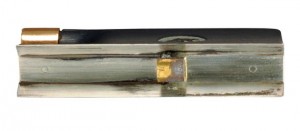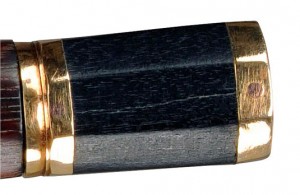Newsletter / May 2013

Etienne Pajeot (1791 – 1849)
An examination of a very fine ebony and gold violin bow
Made between 1840 and 1845 by the celebrated Etienne Pajeot, this illustrative example shows the striking power and elegance of one of the most innovative and influential craftsmen to emerge from the golden age of French bowmaking, notwithstanding the given conditions of limited material goods in his very last period.
In spite of the fact that Pajeot in this bow used minimal amounts of expensive and rare materials like gold and copper, he created an exciting and almost glamorous example of French bowmaking.
As we expect, this bow was made with precise and fast workmanship. The stick is finished to a very high standard, made from exceptional Pernambuco, golden and orange in colour. The chamfers of the elegant head are even and clean.

The Frog
The frog is mounted with a narrow and thin ferrule, the heelplate is reduced in size when compared to Pajeot’s nickel or silver work – an attempt to make something special while being frugal. The liner of the frog is made of silver and is an upgrade in durability from the 100% copper liners found on many earlier gold-mounted bows.
The Liner

While the aesthetics of silver and gold together on the same frog may seem strange at first glance, Pajeot must have seen the copper liners of some of his earlier gold-mounted bows deteriorate and turn green, whereas the silver tarnishes elegantly to an ebony black. As you can see in the illustration, this decision to use silver had a positive influence on the beauty of the bow.
The Button
The button, formerly questioned by traditional expertise, is indeed original and stylistically an homage to Pajeot’s father’s work.

The gold of the two rings is identical with the gold on the frog, and Рby the way Рabsolutely identical to other famous Pajeots, such as the ex-Ysaye/ex-Stern (the elemental composition shows a concentration of 71.06% gold, 21.32% copper and 7.61% silver). Also, the ebony used for the button matches the wood of the frog and finds congruence with other Pajeot ebony, according to the Ebony Database(© ) of the authors.
About Gold
In addition, the screw, the eyelet, and even the mother-of-pearl are still original on this wonderfully preserved bow.

An often-told myth is that as a rule all French bowmakers used 18K gold. After testing the gold on many French bows it has become clear that many indeed did, but some very important bowmakers did not. It is the responsibility of today’s experts not just to adopt these generalities as “facts” or “rules”, but to challenge the accuracy of a statement and to research it in a much deeper way. Otherwise it will limit our understanding of such a fine, intelligent and innovative maker and this period of French bowmaking in general.
Summary
In summary, this bow emphasizes Pajeot’s special position in the ranks of the greatest bowmakers next to Francois Xavier Tourte, J.P.M. Persoit and Dominique Peccatte. It embodies his ingenious oeuvre made in Mirecourt, far away from Paris.
Authors
Stephan Jansen, London / Isaac Salchow, New York City
Copyright
Isaac Salchow, NYC / Stephan Jansen, London – All Rights Reserved.
